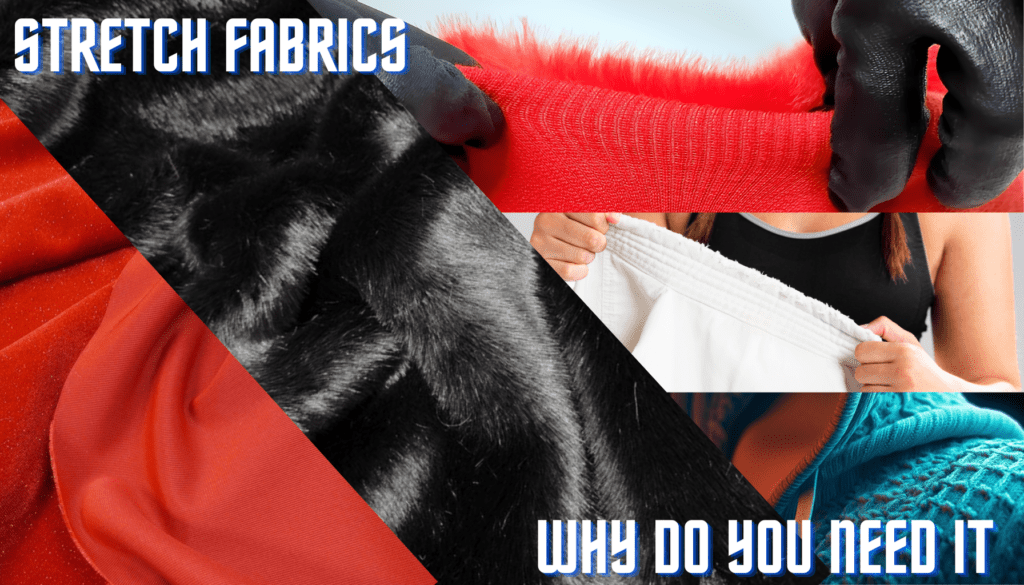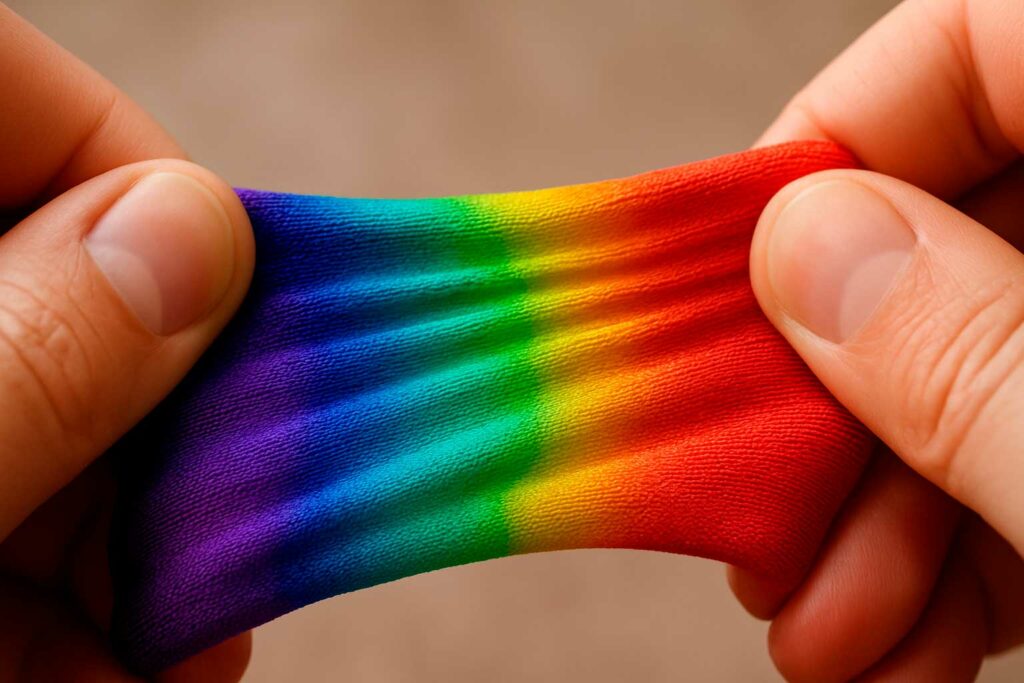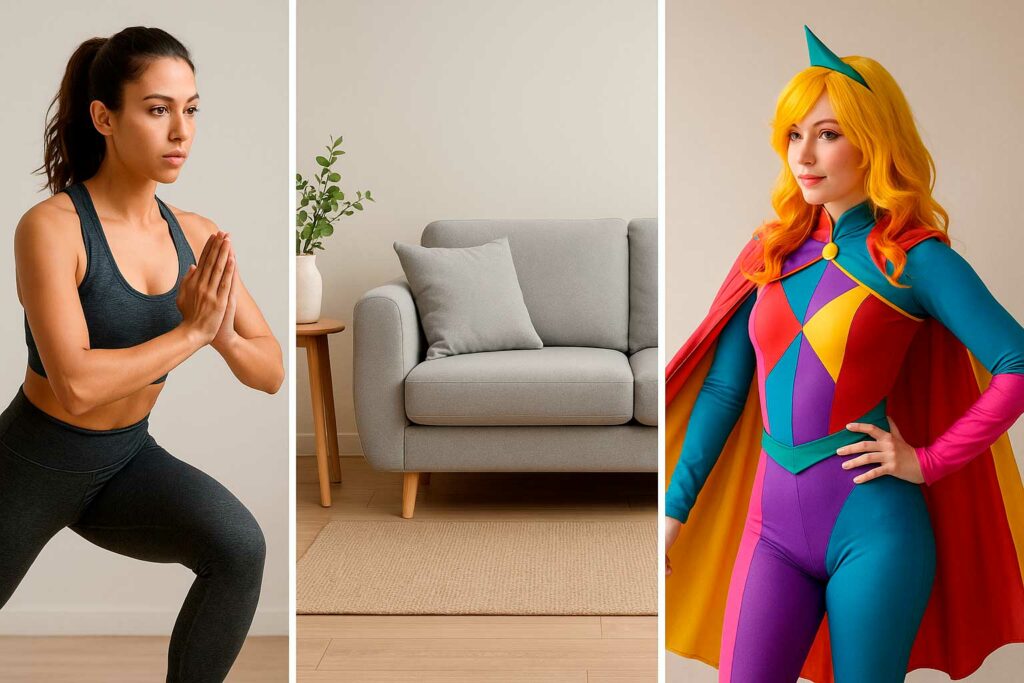
Stretchable fabric unlocks new and exciting project applications. And, as time goes on, finding a way to add stretch to historically non-stretchable fabrics has allowed for old application to take on new life. From jeans, to costuming, and upholstery, finding the right stretch fabric can be a bit confusing. So let’s try to untangle it all a bit and give a bit of insight into stretch fabrics.
What Are Stretch Fabrics?
Stretch fabrics are textiles designed to stretch and return to their original shape. This elasticity is achieved through the inclusion of elastic fibers, such as spandex, or through specific knit structures. Stretch fabrics can vary in their elasticity—some stretch in one direction (two-way stretch), while others stretch in multiple directions (four-way stretch).
Key components of stretch fabrics include:
Base Fibers: Cotton, polyester, nylon, or other materials blended with elastic fibers.
Elastic Fibers: Spandex (also known as elastane) is the most common, with branded versions like Lycra leading the market.
Knit or Woven Structure: Knitted fabrics generally offer more stretch than woven ones.

Spandex: The Elastic Superstar
Spandex is a synthetic fiber known for its exceptional elasticity. Invented in 1958 by chemist Joseph Shivers, it’s made primarily of polyurethane, a polymer that allows it to stretch up to five times its original length and snap back into place.
Uses of Spandex
Spandex is a staple in a wide range of applications:
Athletic Wear: Yoga pants, compression garments, and cycling shorts benefit from spandex’s flexibility and support.
Undergarments: Bras, underwear, and shapewear often include spandex for a snug yet comfortable fit.
Medical Applications: Compression socks, bandages, and braces utilize spandex for therapeutic benefits.
Fashion: Skinny jeans, bodycon dresses, and swimwear often incorporate spandex for a tailored fit.
Pros of Spandex
High Elasticity: Offers excellent stretch and recovery.
Lightweight: Adds minimal bulk to garments.
Durable: Resistant to wear and tear.
Comfortable: Provides a smooth, form-fitting feel.
Cons of Spandex
Heat Sensitivity: Degrades with high heat, making ironing a challenge.
Chemical Sensitivity: Vulnerable to damage from bleach and harsh detergents.
Cost: More expensive than non-elastic fibers.
Lycra: A Branded Marvel
Lycra is a brand name for spandex, developed by DuPont. While chemically identical to generic spandex, Lycra has become synonymous with high-quality elastic fibers due to its consistent performance and durability.
Uses of Lycra
Lycra’s applications mirror those of generic spandex, but it’s particularly favored in high-performance apparel:
Sportswear: Enhances mobility and support in running tights, swimwear, and activewear.
Casual Wear: Used in denim, T-shirts, and leggings for added comfort.
Luxury Fashion: Often found in designer garments for a sleek silhouette.
Pros of Lycra
Reliable Quality: Maintains shape and elasticity over time.
Versatility: Works well with various base fabrics.
Moisture Management: Often paired with moisture-wicking technologies.
Cons of Lycra
Price Premium: More expensive than generic spandex.
Environmental Concerns: Non-biodegradable, contributing to textile waste.
Elastic Blends: Combining Strengths
Elastic blends are fabrics that combine elastic fibers (like spandex) with other materials, such as cotton, polyester, or nylon. These blends balance the stretchiness of elastic fibers with the characteristics of the base material.
Uses of Elastic Blends
Everyday Clothing: Stretch jeans, leggings, and T-shirts for enhanced comfort.
Outerwear: Jackets and coats with stretch panels for better mobility.
Specialty Applications: Maternity wear, performance gear, and industrial textiles.
Pros of Elastic Blends
Customizability: Properties can be tailored by adjusting the blend ratio.
Enhanced Comfort: Combines the softness of natural fibers with elasticity.
Cost-Effective: Often more affordable than pure elastic fabrics.
Cons of Elastic Blends
Limited Stretch: May not be as elastic as pure spandex.
Durability Issues: Blends with natural fibers can degrade faster.
Creative Uses for Stretch Fabrics
Athletic and Performance Wear
Stretch fabrics are a staple in sports and fitness apparel. Four-way stretch fabrics are particularly valuable for activities requiring a wide range of motion, such as yoga, dance, and gymnastics.
Medical Textiles
Compression garments, bandages, and orthopedic supports rely on stretch fabrics for their functionality. The elasticity helps improve circulation and provides targeted support.
Fashion and Everyday Wear
From skinny jeans to fitted dresses, stretch fabrics are a favorite in fashion. They offer a flattering fit and ensure comfort throughout the day.
Industrial and Technical Uses
Stretch fabrics are also used in niche applications, such as automotive upholstery, space suits, and protective gear.

Why Buy Stretch Fabrics from Big Z Fabric?
At Big Z Fabric, we carry an extensive range of high-quality stretch materials in a variety of vibrant colors, unique textures, and finishes. Our selection includes both 2-way and 4-way stretch fabrics, carefully sourced and stocked in large quantities for fast, reliable fulfillment.
Based in Downtown Los Angeles, we serve customers across the U.S. who demand both value and versatility. Whether you’re making apparel, upholstery, or performance wear, our stretch fabrics are built to meet your creative and functional needs.
Sustainability Concerns
Stretch fabrics, particularly those made from synthetic fibers, pose environmental challenges:
Non-Biodegradability: Synthetic fibers like spandex and Lycra contribute to long-term waste.
Microplastics: Washing synthetic fabrics can release microplastics into waterways.
Production Impact: Manufacturing elastic fibers requires significant energy and chemical use.
Sustainable Alternatives
Recycled Spandex: Made from post-consumer waste, offering a lower environmental footprint.
Biodegradable Blends: Innovations in natural elastic fibers are emerging.
Circular Fashion: Recycling and repurposing stretch garments can reduce waste.
Frequently Asked Questions
What's the difference between 2-way and 4-way stretch?
2-way stretches in one direction, while 4-way stretches both horizontally and vertically.
Can stretch fabrics be machine washed?
Yes, but cold wash and air-dry is usually best to preserve elasticity.
Is Lycra more durable than spandex?
They are essentially the same in durability, but Lycra ensures brand consistency.
Ready to Stretch Your Creativity?
Stretch fabrics give you the freedom to create pieces that fit, move, and stand out. From breathable activewear to flexible home décor, our collection includes spandex, Lycra, and elastic blends that combine comfort with durability.
At Big Z Fabric, we offer these materials by the yard with wholesale pricing and fast U.S. shipping, making it easy to get the stretch you need—when you need it. Choose from a wide variety of colors, finishes, and stretch levels to match your exact project requirements.
Take your ideas further with fabrics designed to move.
